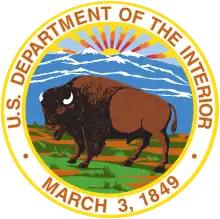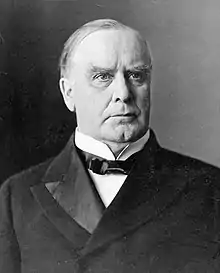Cornelius Newton Bliss
Cornelius Newton Bliss (January 26, 1833 – October 9, 1911) was an American merchant, politician and art collector, who served as Secretary of the Interior in the administration of President William McKinley and as Treasurer of the Republican National Convention in four successive campaigns.[1]
Cornelius Bliss | |
|---|---|
 | |
| 21st United States Secretary of the Interior | |
| In office March 6, 1897 – February 19, 1899 | |
| President | William McKinley |
| Preceded by | David R. Francis |
| Succeeded by | Ethan Hitchcock |
| Chair of the New York Republican Party | |
| In office 1897–1899 | |
| Preceded by | Chester S. Cole |
| Succeeded by | John N. Knapp |
| Personal details | |
| Born | Cornelius Newton Bliss January 26, 1833 Fall River, Massachusetts, U.S. |
| Died | October 9, 1911 (aged 78) New York City, New York, U.S. |
| Political party | Republican |
| Spouse(s) | Mary Plummer
(m. 1859; |
| Children | 4, including Lillie, Cornelius |
Early life

Cornelius Bliss was born at Fall River, Massachusetts. He was the son of Asahel Newton and Irene Borden (née Luther) Bliss.[2] His family was of English ancestry and their earliest American ancestor was Thomas Bliss, who emigrated from Belstone, Devonshire to New England in 1635.[3] His father died when he was an infant and his mother remarried to Edward S. Keep. They moved to New Orleans in 1840.[2]
He was educated in his native city and in New Orleans, where he early entered his stepfather's counting house.[2]
Career
Returning to Massachusetts in 1849, he became a clerk and subsequently a junior partner in a prominent Boston commercial house. Later he moved to New York City to establish a branch of the firm. The firm, originally Wright & Whitman, in 1874 became Wright, Bliss & Fabyan upon the death of the senior partner, Mr. John S. Wright. On the death in 1881 of Mr. Eben Wright,[4] the firm became Bliss, Fabyan & Co., under which name it continued until well into the 20th Century.[5] Bliss, Fabyan & Co. was one of the largest wholesale dry-goods houses in the country.[6]
Politics
A consistent advocate of the protective tariff, he was one of the organizers and for many years president of the American Protective Tariff League. In politics an active Republican, he was chairman of the Republican state committee in 1887 and 1888, and contributed much to the success of the Harrison ticket in New York in the latter year. He was treasurer of the Republican National Committee from 1892 to 1904.[7] He turned down the offer of becoming United States Secretary of the Treasury under President McKinley,[8] but he served as United States Secretary of the Interior in President William McKinley's cabinet from 1897 to 1899.[9][10][11]
In 1900, he was invited to stand as President McKinley's vice-president.[12][13] He refused the offer.[14][15] The following year McKinley was assassinated and Roosevelt (who did accept the offer) became President.[16]
Personal life

On March 30, 1859,[2] Bliss was married to Mary Elizabeth Plummer (1837–1923), the daughter of Hon. Avery Plummer of Boston.[17] Together, they were the parents of four children, two who survived him:[3]
- Nellie Bliss (b. 1861), who died young.[3]
- Lizzie Plummer Bliss (1864–1931), one of the founders of the Museum of Modern Art in New York City.[18]
- George Bliss, who died young.[3]
- Cornelius Newton Bliss Jr. (1875–1949),[19] a prominent financier who married Zaidee Cobb (1881-1966).[20]
He was also a member of the famous Jekyll Island Club (aka The Millionaires Club) on Jekyll Island, Georgia.[21]
Bliss' health began to fail in 1910. He spent the Summer of 1911 at his country home in Rumson, New Jersey, accompanied by his physician Arthur W. Bingham, but returned to New York City in September due to his frailty. He spent the last two weeks of his life at his residence at 29 East 37th Street before succumbing to heart disease at 7 pm on October 9, 1911.[1] He is buried in Woodlawn Cemetery, Bronx, New York.[22][23]
Legacy
Cornelius Bliss was a collector of fine art. He owned works by Arthur Bowen Davies, along with Claude Monet's The Manneporte near Étretat, now at the Metropolitan Museum of Art.[24][25]
References
- Notes
- Obituary (10 October 1911). "Cornelius N. Bliss, Merchant, is Dead" (PDF). New York Times. Retrieved 28 March 2012.
- The National Cyclopaedia of American Biography: Being the History of the United States as Illustrated in the Lives of the Founders, Builders, and Defenders of the Republic, and of the Men and Women who are Doing the Work and Moulding the Thought of the Present Time. J. T. White Company. 1901. p. 15. Retrieved 25 September 2017.
- Cutter, William Richard (1918). American Biography: A New Cyclopedia. Pub. under the direction of the American historical Society. pp. 342–345. Retrieved 25 September 2017.
- "A RICH MAN'S BEQUESTS; TROUBLE LIKELY TO ARISE OVER EBEN WRIGHT'S WILL". The New York Times. 2 May 1881. Retrieved 25 September 2017.
- "COTTON AGENCIES MERGED; Haywood, Mackay & Valentine to Be Bliss Fabyan Department". The New York Times. 14 April 1936. Retrieved 25 September 2017.
- "COL. GEORGE FABYAN, SCIENTIST, DIES AT 69; l Retired Merchant Widely Known for His Studies of Sound and His War Work". The New York Times. 18 May 1936. Retrieved 25 September 2017.
- Picone, Louis L. (2016). The President Is Dead!: The Extraordinary Stories of the Presidential Deaths, Final Days, Burials, and Beyond. Skyhorse Publishing, Inc. p. 344. ISBN 9781510703773. Retrieved 25 September 2017.
- "THE CABINET COMPLETED; Cornelius N. Bliss of New York Consents to be McKinley's Secretary of the Interior. HAS YIELDED TO PRESSURE. Hanna and New York Friends Persuade Him to Accept Office When He Prefers to Remain in Private Life -- Platt Not Overpleased". The New York Times. 4 March 1897. Retrieved 25 September 2017.
- "VICE PRESIDENTIAL CANDIDATES". The New York Times. 8 December 1899. Retrieved 25 September 2017.
- "A NEW CABINET MEMBER; Ethan Allen Hitchcock Is Appointed Secretary of the Interior. HIS NOMINATION CONFIRMED He Is at Present United States Ambassador to Russia -- Will Succeed Cornelius N. Bliss". The New York Times. 22 December 1898. Retrieved 25 September 2017.
- "THE PUBLIC SERVICE OF MR. BLISS". The New York Times. 27 April 1899. Retrieved 25 September 2017.
- "BLISS STILL THE CHOICE; Vice Presidential Candidate If New York Man Is Named. MR. HANNA'S STRONG PLEADING Friends Believe Mr. Bliss Will Yield to Persuasion -- Woodruff Not to Withdraw". The New York Times. 12 April 1900. Retrieved 25 September 2017.
- "BLISS NOW THE FAVORITE; Many Things Point to His Choice for Vice President. CONFERS WITH SENATOR HANNA That Is Quite Customary, He Explains, Smilingly -- Condolences for Woodruff -- President's Attitude". The New York Times. 10 April 1900. Retrieved 25 September 2017.
- "MR. BLISS NOT A CANDIDATE.; Friends of the New York Merchant Deny that He Desires to Reenter Public Life". The New York Times. 1900. Retrieved 25 September 2017.
- "BLISS BOOM IS REVIVED; Ex-Secretary Will Not Decline Nomination in Advance. MORE TALK OF A STAMPEDE Col. Youngs Does Not Think Gov. Roosevelt Can Be Forced to Run for Vice President". The New York Times. 14 June 1900. Retrieved 25 September 2017.
- "FOR THE McKINLEY MONUMENT.; President Roosevelt Appoints Trustees and They Will Meet at Canton Thursday to Organize". The New York Times. 6 October 1901. Retrieved 25 September 2017.
- "Mrs. Elizabeth M. Bliss". The New York Times. 29 September 1923. Retrieved 25 September 2017.
- "MISS BLISS AND THE MODERN MUSEUM". The New York Times. 16 March 1931. Retrieved 25 September 2017.
- "CORNELIUS BLISS, 74, FINANCIER, IS DEAD; Philanthropist, Formerly Head of Metropolitan Opera Board, Succumbs in Hospital". The New York Times. 6 April 1949. Retrieved 25 September 2017.
- "BLISS-COBB WEDDING.; Son of New York Banker Makes Washington Girl His Wife". The New York Times. 27 April 1906. Retrieved 25 September 2017.
- Hutto, Richard Jay (2005). The Jekyll Island Club Members. Indigo Custom Publishing. pp. 24–27. ISBN 9780977091225. Retrieved 25 September 2017.
- "CORNELIUS N. BLISS BURIED.; Many Prominent Men at Funeral Service -- Rev. Dr. Jefferson's Eulogy". The New York Times. 13 October 1911. Retrieved 25 September 2017.
- "CORNELIUS N. BLISS FUNERAL.; Services at His Home To-morrow Morning -- Eulogy from Taft". The New York Times. 11 October 1911. Retrieved 25 September 2017.
- The Metropolitan Museum of Art. "Heilbrunn Timeline of Art History". The Metropolitan Museum of Art. Retrieved 28 March 2012.
- The Frick Collection. "Archives Directory for the History of Collecting in America". The Frick Collection. Retrieved 27 March 2012.
- Sources
 This article incorporates text from a publication now in the public domain: Chisholm, Hugh, ed. (1911). "Bliss, Cornelius Newton". Encyclopædia Britannica (11th ed.). Cambridge University Press.
This article incorporates text from a publication now in the public domain: Chisholm, Hugh, ed. (1911). "Bliss, Cornelius Newton". Encyclopædia Britannica (11th ed.). Cambridge University Press.
External links
| Party political offices | ||
|---|---|---|
| Preceded by Chester S. Cole |
Chairman of the New York Republican State Committee 1887 – 1889 |
Succeeded by John N. Knapp |
| Political offices | ||
| Preceded by David Rowland Francis |
U.S. Secretary of the Interior Served under: William McKinley 1897 – 1899 |
Succeeded by Ethan A. Hitchcock |

